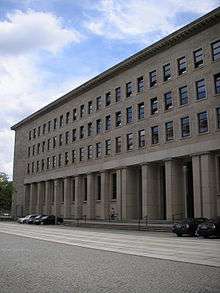Former Reichsbank building

The former Reichsbank building (in German the Haus am Werderschen Markt) is a building in Berlin, Germany, originally built in 1934–38 to house the Reichsbank, and today housing part of the Foreign Office.
One of the remaining examples of Nazi architecture, the building was commissioned in 1933. The design competition attracted a number of entrants, including two Bauhaus architects who would later have to flee the Nazis, Walter Gropius and Ludwig Mies van der Rohe. It was won, however, by Heinrich Wolff, whose design called for a stone-faced structure over a reinforced concrete core.[1]
After World War II, the building, now in East Berlin, first housed East Germany's finance ministry, and from 1959 the ruling Socialist Unity Party. Following reunification, a new headquarters for the Foreign Office was built next door, and the former Reichsbank building became part of its office complex, undergoing modifications for that purpose overseen by Hans Kollhoff.[1]
References
| Wikimedia Commons has media related to Reichsbank-Erweiterungsbau. |
- Hans Wilderotter (Ed.): Das Haus am Werderschen Markt. Jovis, Berlin: 2000/2002, ISBN 3-931321-20-7 German book review
Coordinates: 52°30′50″N 13°23′59″E / 52.5140°N 13.3997°E